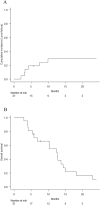Re-irradiation spine stereotactic body radiotherapy following high-dose conventional radiotherapy for metastatic epidural spinal cord compression: a retrospective study
- PMID: 38413551
- PMCID: PMC11139739
- DOI: 10.1007/s11604-024-01539-x
Re-irradiation spine stereotactic body radiotherapy following high-dose conventional radiotherapy for metastatic epidural spinal cord compression: a retrospective study
Abstract
Purpose: We aimed to evaluate the efficacy and safety of re-irradiation stereotactic body radiation therapy (SBRT) in patients with metastatic epidural spinal cord compression (MESCC) following high-dose conventional radiotherapy.
Materials and methods: Twenty-one patients met the following eligibility criteria: with an irradiation history of 50 Gy2 equivalent dose in 2-Gy fractions (EQD2) or more, diagnosed MESCC in the cervical or thoracic spines, and treated with re-irradiation SBRT of 24 Gy in 2 fractions between April 2018 and March 2023. Prior treatment was radiotherapy alone, not including surgery. The primary endpoint was a 1-year local failure rate. Overall survival (OS) and treatment-related adverse events were assessed as the secondary endpoints. Since our cohort includes one treatment-related death (TRD) of esophageal perforation, the cumulative esophageal dose was evaluated to find the dose constraints related to severe toxicities.
Results: The median age was 68, and 14 males were included. The primary tumor sites (esophagus/lung/head and neck/others) were 6/6/7/2, and the median initial radiotherapy dose was 60 Gy2 EQD2 (range: 50-105 Gy2, 60-70/ > 70 Gy2 were 11/4). Ten patients underwent surgery followed by SBRT and 11 SBRT alone. At the median follow-up time of 10.4 months, 17 patients died of systemic disease progression including one TRD. No radiation-induced myelopathy or nerve root injuries occurred. Local failure occurred in six patients, with a 1-year local failure rate of 29.3% and a 1-year OS of 55.0%. Other toxicities included five cases of vertebral compression fractures (23.8%) and one radiation pneumonitis. The cumulative esophageal dose was recommended as follows: Dmax < 203, D0.035 cc < 187, and D1cc < 167 (Gy3 in biological effective dose).
Conclusion: Re-irradiation spine SBRT may be effective for selected patients with cervical or thoracic MESCC, even with high-dose irradiation histories. The cumulative dose assessment across the original and re-irradiated esophagus was recommended to decrease the risk of severe esophageal toxicities.
Keywords: Re-irradiation; Spinal cord compression; Spinal metastases; Stereotactic radiotherapy.
© 2024. The Author(s).
Conflict of interest statement
YK has a speaker’s bureau for Hitachi Co., and received research funding from JSPS (Grant Number 23K14669). TK has a speaker’s bureau for Hitachi Co., Bristol Myers Squibb., Accuray Co., Elekta Co., Ono Pharmaceutical Co., AstraZeneca Co., Taiho Pharmaceutical Co., Canon Co., and Janssen Pharmaceutical Co.
Figures




Similar articles
-
Postoperative re-irradiation using stereotactic body radiotherapy for metastatic epidural spinal cord compression.J Neurosurg Spine. 2018 Sep;29(3):332-338. doi: 10.3171/2018.1.SPINE171155. Epub 2018 Jun 15. J Neurosurg Spine. 2018. PMID: 29905524
-
Reirradiation of metastases of the central nervous system: part 2-metastatic epidural spinal cord compression.Ann Palliat Med. 2024 Jul;13(4):1141-1149. doi: 10.21037/apm-23-594. Epub 2024 Mar 21. Ann Palliat Med. 2024. PMID: 38600819 Review.
-
Re-irradiation stereotactic body radiotherapy for spinal metastases: a multi-institutional outcome analysis.J Neurosurg Spine. 2016 Nov;25(5):646-653. doi: 10.3171/2016.4.SPINE151523. Epub 2016 Jun 24. J Neurosurg Spine. 2016. PMID: 27341054
-
Vertebral compression fractures after stereotactic body radiation therapy: a large, multi-institutional, multinational evaluation.J Neurosurg Spine. 2016 Jun;24(6):928-36. doi: 10.3171/2015.10.SPINE141261. Epub 2016 Feb 19. J Neurosurg Spine. 2016. PMID: 26895526
-
Treatment of ambulatory patients with metastatic epidural spinal cord compression: a systematic review and meta-analysis.J Neurosurg Spine. 2023 Oct 27;40(2):175-184. doi: 10.3171/2023.8.SPINE23541. Print 2024 Feb 1. J Neurosurg Spine. 2023. PMID: 37890190
Cited by
-
Frequency of and risk factors associated with local recurrence after spinal stereotactic body radiation therapy without surgery.J Neurooncol. 2024 Sep;169(3):563-570. doi: 10.1007/s11060-024-04755-7. Epub 2024 Jul 24. J Neurooncol. 2024. PMID: 39046598
References
-
- NCCN guidelines available at http://www.nccn.org/professionals/physician_gls/f_guidelines.asp. Accessed 16 Aug 2023. cns.
MeSH terms
Grants and funding
LinkOut - more resources
Full Text Sources
Miscellaneous

